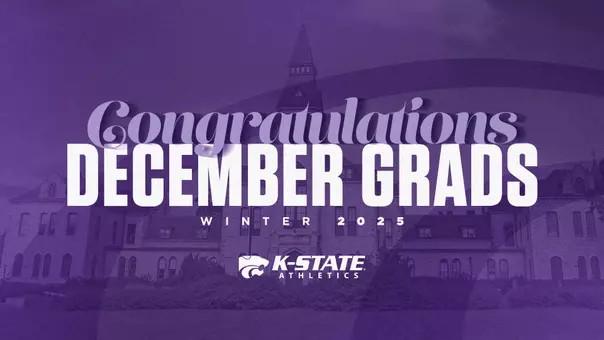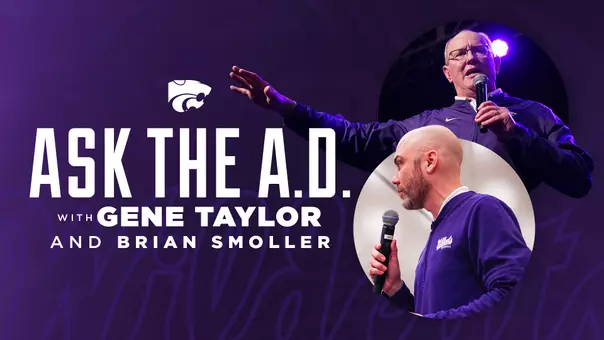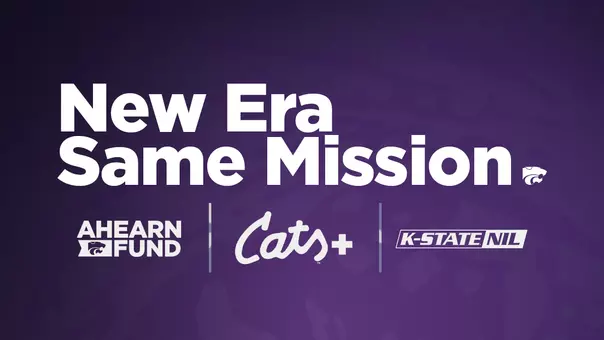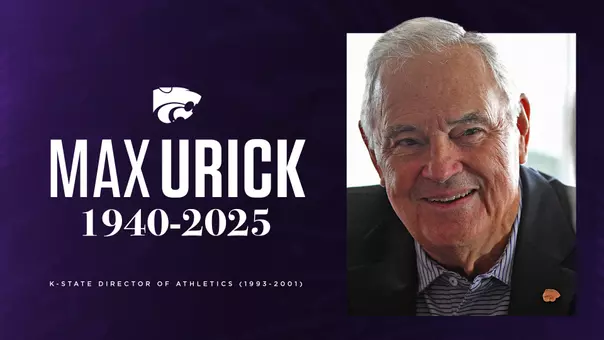Kansas State University Athletics
Ask The A.D. — The Future | Part 3
Feb 19, 2025 | Athletics
Brian Smoller (BS): Hello and welcome to another edition of our special Ask the AD - The Future. This is part three of our three video series outlining the incoming changes to college athletics, at least for what is known with the House settlement, which we've outlined before, what it all means for K-State, and where we stand right now and then, what we're going to see moving ahead. And that's kind of where we're at today, and as we move into this, it's a different setting for us, for Ask the AD here, because it is a little bit more of a serious tone here as we move forward into this third video. So, thanks for doing this. I appreciate it.
Gene Taylor (GT): No Brian, it is. And obviously, you know the message today is just the fact that how important this is for K-State Athletics. And the reason we've done this, we wanted to lay the groundwork as to how we got here, why we're here, and then today, the importance of how we move forward. And it's critical that we have this conversation in a little different setting.
BS: All right, so let's if you've seen, haven't seen the first two videos, go back and watch those. We're not going to go through everything that we went through already before, but we talked about the House settlement. What it is, what it means for K-State. It's about an extra 22 maybe a little bit more $23 million a year as an added expense. So, let's get into some specifics here. How does K-State go about, on the athletic side, raising this money?
GT: Well, it's, you know, it's going to be a challenge. And we've looked at so many ways. Obviously, we've looked at the expense side. Are there areas that we can trim? And, you know, we've been a very efficient budget. We've not been a budget with a lot of fluff. We do what we need to do operationally to have success, to pay the salaries, the best we can pay them. But we went through that process, and said, 'Okay, where is it that we can find dollars?' And we found a little bit, and we're going to continue to do that. The other side is revenue. Where do we find additional revenue? Is it through additional ticket pricing? We've looked at Bramlage ticket pricing. Some of the stuff we haven't increased in 14 years. And so we don't want to put it all on the burdens of our fans, but there's a lot of ways in which we haven't touched in terms of pricing, football parking, football tickets prices, basketball, Ahearn fund memberships, all of those things we're going to continue to look at. And then, what are the revenue sources are we not touching? And we did something this year with concessions, where they could round up, you know, which, you know, brought in a little money, but it certainly is an easy way for fans to help without a heavy burden. So we're looking at so many areas, because it's going to take a lot to get to this. It's really a $22 million new budget line item, and that's a heavy lift.
BS: You've also talked about possibly naming rights for Bramlage Coliseum, logos on the football field. It seems like all the everything is kind of in play.
GT: Yeah, you know. And some of that's new, right? The logo on the football field was a rule passed by the NCAA that allows us to do that. It came kind of late last year, so we really couldn't find and get it out to sponsors or people that might be interested. So we're going to focus on that. But that could be a significant revenue source for us. Obviously, we've talked about the Bramlage naming, right? We're still working through that process. Are there other opportunities within our stadium and venues that we're missing in terms of opportunities to generate more revenue?
BS: Yeah, and one thing that could be on the horizon, as well as a membership, sort of fan club, sort of service that provides some behind the scenes stuff as well.
GT: Yeah, you know, I think one of the things you know, our fans, we want to be able to give them is more access, you know, individually. Whether it's, you know, behind the scenes interviews, stuff that they don't see publicly, that they may be able to join for a 50 or $100 a month membership, and get access to things that they wouldn't normally get, and then maybe even get into some drawings for specialized tickets or specialized, you know, gear that we could send them. So we're looking at that, and I think that places that have done it have had success with it, and it's grown not only interest, but it's growing their fan base in areas that maybe from parts of the country that aren't necessarily able to come to Manhattan, but they're in Florida, California or Texas or somewhere, and they become their fans, but now they have access that they didn't have before.
BS: So in short, I mean, taking this challenge on, it's obviously going to be significant. It's going to require all of us to do our part as Wildcat fans, we have a lot of pride as K-State fans in doing it ourselves, and that's way we've done it in the past. But that sort of passion, that drive, that there is a positive it feels like for K-State as we launch into this new era, what do you see as maybe giving K-State a bit of an edge?
GT: Well, a couple of things. One is that that fan base, obviously, we've got a tremendous fan base. They're passionate. They love this place. They have a great pride, not only an athletic program, but this institution, and it means so much to them. And over the years, you know, they've been with us for a lot of years, and there were years we weren't very successful, and they understood that. They bought into that, and they found the vision way to help us, and they continue to help us. Facilities - right? We have some of the best facilities in the country. Our donors stepped up when that was a need for us, and they built it. We are sitting in one. We have the new Shamrock Football Indoor Practice Field. We have the new Morgan Family Volleyball Arena. We have the new Shamrock Zone. All these facilities, you know, baseball upgrades, soccer upgrades. But the fans understood the importance of that. Well, guess what? That's pretty well taken care of. And so these massive facility campaigns that we've asked them to step up, and which they did, aren't going to happen for a long time. So, we don't have major facility needs, because you all stepped up and took care of that. And so now we can focus on this as our number one priority from a campaign perspective.
BS: And scholarship numbers as well. It feels like the scholarship dollars here will go farther than perhaps at some other schools.
GT: Yeah, you know, obviously our tuition base is low and then our expenses are low compared to a lot of other schools. I mean, a Baylor and a TCU, the scholarship costs a lot more money than it does here, but we're going to add additional scholarship, almost 40 scholarships, to be able to continue to grow our program and match the revenue generation or the revenue sharing that we have to match. But it's been the fan base, it's been our donors, it's been our people that support us, that gotten us there. And so, you know, our Ahearn Fund staff, they're going to come see you, they're going to come talk to you, and please, you know, listen to them, because they have a great story to tell. We're going to start basically a campaign. And I think, you know, I think it's probably $100 million campaign over the next five years, just like we've had facility campaigns over the last several years. So this is a new campaign for us, and it's so critically important that people take part.
BS: All right, so instead of building a building, we're building the future here with this $100 million campaign. So let's, I'll give you the minute here, just a one on one, talk to the fans, give them your pitch here. What do you want to say in this pivotal time today?
GT: You know, Brian, that's a great question. And you know, as I was walking in here today, I looked and we have a lot of great stories, right? Bowl games from, you know, from the days back. And we also have pictures of our stadium that when we didn't have the success that we've had, but we've enjoyed success so much in all of our sports over the last several years that we can't afford to go backwards. We need to continue to win championships. I want championships. Coaches want championships. We've invested and been able to hire great coaches and great staff. We have tremendous folks that work very hard in our staff to make this program as good as it possibly can be. And everybody that I'm talking to, our fan base, our ticket buyers, our friends or you know, our families, they have stepped up and put us in the situation where we're successful today and we don't want to go back. We all want to win conference championships. We all want to go to the NCAA tournament. We all want to have a chance to be in the final 12 in football and certainly win a national championship at some point. We love going to basketball tournaments and Elite Eights and Super Regionals and all that stuff. We can't do it if we don't meet this goal of this 20 million. We're going to need everybody to step up, every one of us. And we can't do it without you. We haven't been able to do it before without you, and we need to continue to have your support. It's critically important for us to have continued success.
BS: Well said. And again, K-State Athletics has such an impact here in the region, the city, this area, the state, and we want to continue to see that half a billion-dollar impact continue to be into the future. So, we'll do what we always do as K-Staters. We pull together, we find that grit, determination and pride, and somehow we all find a way to get it done, looking forward to seeing what the future holds. Thanks again for doing these.
GT: Thanks and we thank everybody for listening, and let's get on board, and let's keep this thing going.
BS: That'll do it for our special Ask the AD - The Future. You can go back and watch all these videos on kstatesports.com. And of course, ahearnfund.com is the place you want to go check out for more information on the campaign to help build the future for K-State. For Gene Taylor, Director of Athletics, I'm Brian Smoller. Thank you for watching. Bye.
Gene Taylor (GT): No Brian, it is. And obviously, you know the message today is just the fact that how important this is for K-State Athletics. And the reason we've done this, we wanted to lay the groundwork as to how we got here, why we're here, and then today, the importance of how we move forward. And it's critical that we have this conversation in a little different setting.
BS: All right, so let's if you've seen, haven't seen the first two videos, go back and watch those. We're not going to go through everything that we went through already before, but we talked about the House settlement. What it is, what it means for K-State. It's about an extra 22 maybe a little bit more $23 million a year as an added expense. So, let's get into some specifics here. How does K-State go about, on the athletic side, raising this money?
GT: Well, it's, you know, it's going to be a challenge. And we've looked at so many ways. Obviously, we've looked at the expense side. Are there areas that we can trim? And, you know, we've been a very efficient budget. We've not been a budget with a lot of fluff. We do what we need to do operationally to have success, to pay the salaries, the best we can pay them. But we went through that process, and said, 'Okay, where is it that we can find dollars?' And we found a little bit, and we're going to continue to do that. The other side is revenue. Where do we find additional revenue? Is it through additional ticket pricing? We've looked at Bramlage ticket pricing. Some of the stuff we haven't increased in 14 years. And so we don't want to put it all on the burdens of our fans, but there's a lot of ways in which we haven't touched in terms of pricing, football parking, football tickets prices, basketball, Ahearn fund memberships, all of those things we're going to continue to look at. And then, what are the revenue sources are we not touching? And we did something this year with concessions, where they could round up, you know, which, you know, brought in a little money, but it certainly is an easy way for fans to help without a heavy burden. So we're looking at so many areas, because it's going to take a lot to get to this. It's really a $22 million new budget line item, and that's a heavy lift.
BS: You've also talked about possibly naming rights for Bramlage Coliseum, logos on the football field. It seems like all the everything is kind of in play.
GT: Yeah, you know. And some of that's new, right? The logo on the football field was a rule passed by the NCAA that allows us to do that. It came kind of late last year, so we really couldn't find and get it out to sponsors or people that might be interested. So we're going to focus on that. But that could be a significant revenue source for us. Obviously, we've talked about the Bramlage naming, right? We're still working through that process. Are there other opportunities within our stadium and venues that we're missing in terms of opportunities to generate more revenue?
BS: Yeah, and one thing that could be on the horizon, as well as a membership, sort of fan club, sort of service that provides some behind the scenes stuff as well.
GT: Yeah, you know, I think one of the things you know, our fans, we want to be able to give them is more access, you know, individually. Whether it's, you know, behind the scenes interviews, stuff that they don't see publicly, that they may be able to join for a 50 or $100 a month membership, and get access to things that they wouldn't normally get, and then maybe even get into some drawings for specialized tickets or specialized, you know, gear that we could send them. So we're looking at that, and I think that places that have done it have had success with it, and it's grown not only interest, but it's growing their fan base in areas that maybe from parts of the country that aren't necessarily able to come to Manhattan, but they're in Florida, California or Texas or somewhere, and they become their fans, but now they have access that they didn't have before.
BS: So in short, I mean, taking this challenge on, it's obviously going to be significant. It's going to require all of us to do our part as Wildcat fans, we have a lot of pride as K-State fans in doing it ourselves, and that's way we've done it in the past. But that sort of passion, that drive, that there is a positive it feels like for K-State as we launch into this new era, what do you see as maybe giving K-State a bit of an edge?
GT: Well, a couple of things. One is that that fan base, obviously, we've got a tremendous fan base. They're passionate. They love this place. They have a great pride, not only an athletic program, but this institution, and it means so much to them. And over the years, you know, they've been with us for a lot of years, and there were years we weren't very successful, and they understood that. They bought into that, and they found the vision way to help us, and they continue to help us. Facilities - right? We have some of the best facilities in the country. Our donors stepped up when that was a need for us, and they built it. We are sitting in one. We have the new Shamrock Football Indoor Practice Field. We have the new Morgan Family Volleyball Arena. We have the new Shamrock Zone. All these facilities, you know, baseball upgrades, soccer upgrades. But the fans understood the importance of that. Well, guess what? That's pretty well taken care of. And so these massive facility campaigns that we've asked them to step up, and which they did, aren't going to happen for a long time. So, we don't have major facility needs, because you all stepped up and took care of that. And so now we can focus on this as our number one priority from a campaign perspective.
BS: And scholarship numbers as well. It feels like the scholarship dollars here will go farther than perhaps at some other schools.
GT: Yeah, you know, obviously our tuition base is low and then our expenses are low compared to a lot of other schools. I mean, a Baylor and a TCU, the scholarship costs a lot more money than it does here, but we're going to add additional scholarship, almost 40 scholarships, to be able to continue to grow our program and match the revenue generation or the revenue sharing that we have to match. But it's been the fan base, it's been our donors, it's been our people that support us, that gotten us there. And so, you know, our Ahearn Fund staff, they're going to come see you, they're going to come talk to you, and please, you know, listen to them, because they have a great story to tell. We're going to start basically a campaign. And I think, you know, I think it's probably $100 million campaign over the next five years, just like we've had facility campaigns over the last several years. So this is a new campaign for us, and it's so critically important that people take part.
BS: All right, so instead of building a building, we're building the future here with this $100 million campaign. So let's, I'll give you the minute here, just a one on one, talk to the fans, give them your pitch here. What do you want to say in this pivotal time today?
GT: You know, Brian, that's a great question. And you know, as I was walking in here today, I looked and we have a lot of great stories, right? Bowl games from, you know, from the days back. And we also have pictures of our stadium that when we didn't have the success that we've had, but we've enjoyed success so much in all of our sports over the last several years that we can't afford to go backwards. We need to continue to win championships. I want championships. Coaches want championships. We've invested and been able to hire great coaches and great staff. We have tremendous folks that work very hard in our staff to make this program as good as it possibly can be. And everybody that I'm talking to, our fan base, our ticket buyers, our friends or you know, our families, they have stepped up and put us in the situation where we're successful today and we don't want to go back. We all want to win conference championships. We all want to go to the NCAA tournament. We all want to have a chance to be in the final 12 in football and certainly win a national championship at some point. We love going to basketball tournaments and Elite Eights and Super Regionals and all that stuff. We can't do it if we don't meet this goal of this 20 million. We're going to need everybody to step up, every one of us. And we can't do it without you. We haven't been able to do it before without you, and we need to continue to have your support. It's critically important for us to have continued success.
BS: Well said. And again, K-State Athletics has such an impact here in the region, the city, this area, the state, and we want to continue to see that half a billion-dollar impact continue to be into the future. So, we'll do what we always do as K-Staters. We pull together, we find that grit, determination and pride, and somehow we all find a way to get it done, looking forward to seeing what the future holds. Thanks again for doing these.
GT: Thanks and we thank everybody for listening, and let's get on board, and let's keep this thing going.
BS: That'll do it for our special Ask the AD - The Future. You can go back and watch all these videos on kstatesports.com. And of course, ahearnfund.com is the place you want to go check out for more information on the campaign to help build the future for K-State. For Gene Taylor, Director of Athletics, I'm Brian Smoller. Thank you for watching. Bye.
K-State Men's Basketball | Postgame Highlights at Creighton
Sunday, December 14
K-State Men's Basketball | Postgame Press Conference at Creighton
Saturday, December 13
K-State Athletics | Ask the A.D. with Gene Taylor - Dec. 12, 2025
Friday, December 12
K-State Men's Basketball | Creative Highlights vs Mississippi Valley State
Thursday, December 11





